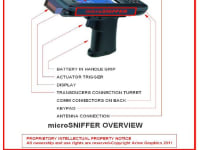The microSNIFFER is a portable electronic monitoring device for detecting and reporting hazardous materials.
The benefits of the microSNIFFER are as follows:
Local and remote monitoring; small size; long battery life; gas, liquid and solid monitoring functions; low-cost. This design idea will improve quality of life; facilitate tedious tasks; help prevent injury or death; improve public safety and security; save time; effort and money. For example, enhanced microSNIFFERs could replace drug-sniffing dogs at airports, saving the time and money spent in training the dogs, as well as the effort and expense in acquiring and caring for these dogs.
The device accepts interchangeable sensor array blocks, such as laser spectroscopes; gas sensors; contact sensors; radiation sensors; chemical sensors. This allow detection of a variety of dangerous materials
The microSNIFFER has beneficial application in industry, commerce, US customs, research, medicine, security and law enforcement. The microSNIFFER is intended for potentially hazardous environments, such as mines, breweries, laboratories, tunnels, etc... It is also intended to detect dangerous materials such as illegal narcotics, dangerous chemicals, explosives, tainted foodstuffs, etc...
There are numerous existing sites for the applications previously listed to recognize that an enormous market potential exists.
The Principles of Operation are as follows:
The microSNIFFER comprises three salient functional blocks -- the transducer (the sensor array) block or turret; the computer (or processing) block; the output (or reporting) block.
The input sampling interval is one second with each sensor being sampled sequentially at this rate. The data input from any sensor along with its associated output is processed when that sensor is sampled. The device is set to a low power mode between samples. Since the estimated processing time is in the sub-millisecond range, the duty cycle relative to the sampling interval is very small. This provides a very low average battery drain.
The heart of the microSNIFFER is the Texas Instruments TI-AM3517 processor with ARM Cortex-A8 core. The Texas Instruments TI-AM3517 low power requirement makes it suitable for battery operated devices such as the microSNIFFER. Also, internal peripheral capabilities such as the serial ports and the onboard radio transceiver allow for significant savings in external parts and printed circuit real estate. The output block comprises the display and audio annunciators (plus their drivers) along with a small antenna sub-system.
The appropriate transducer software application modules are automatically recognized and invoked to match whatever transducer is plugged in.
The hardware is manufactured using these salient elements:
A molded clamshell case, made of plastic; the printed circuit module; a battery housed in the handle, and the various transducer modules.
The printed circuit board contains all of the electronic components, including the antenna and standard interface connectors
Like this entry?
-
About the Entrant
- Name:Fred Rupinski
- Type of entry:individual
- Software used for this entry:Altium Designer, TI Code Composer, CAD
- Patent status:none








